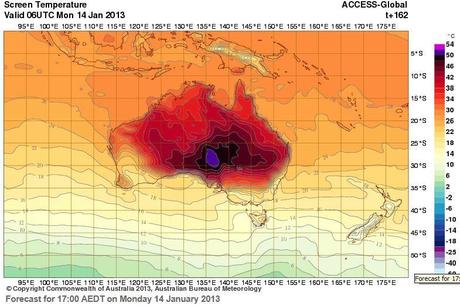This is the coldest time of year in the Prairies. Below -20 °C it all feels about the same, but the fuel lines in cars freeze more easily, and outdoor sports are no longer safe. We all become grouchy creatures of the indoors for a few months each year. But as much as I hate the extreme cold, I would rather be here than in Australia right now.
A record-breaking, continent-wide heat wave has just wrapped up, and Australia has joined the Arctic in the list of regions where the temperature is so unusually warm that new colours have been added to the map legends. This short-term forecast by the ACCESS model predicts parts of South Australia to reach between 52 and 54 °C on Monday:

For context, the highest temperature ever recorded on Earth was 56.7 °C, in Death Valley during July of 1913. Australia’s coming pretty close.
This heat wave has broken dozens of local records, but the really amazing statistics come from national average daily highs: the highest-ever value at 40.33 °C, on January 7th; and seven days in a row above 39 °C, the most ever, from January 2nd to 8th.
Would this have happened without climate change? It’s a fair question, and (for heat waves at least) one that scientists are starting to tackle – see James Hansen’s methodology that concluded recent heat waves in Texas and Russia were almost certainly the result of climate change.
At any rate, this event suggests that uninformed North Americans who claim “warming is a good thing” haven’t been to Australia.
